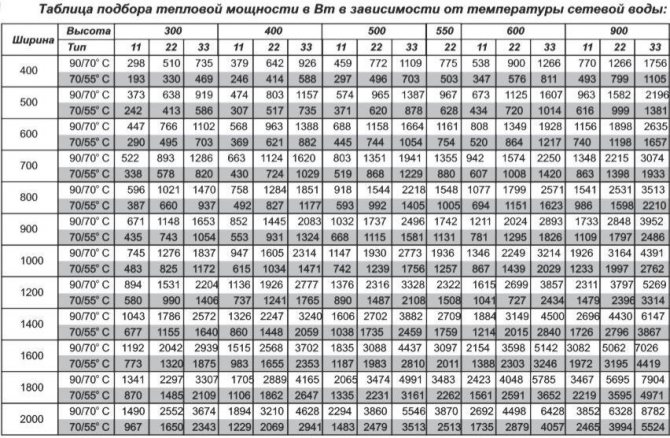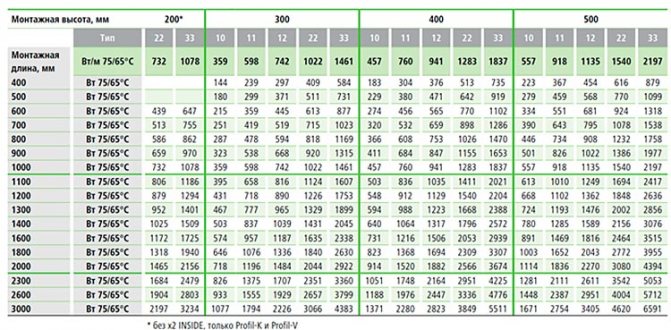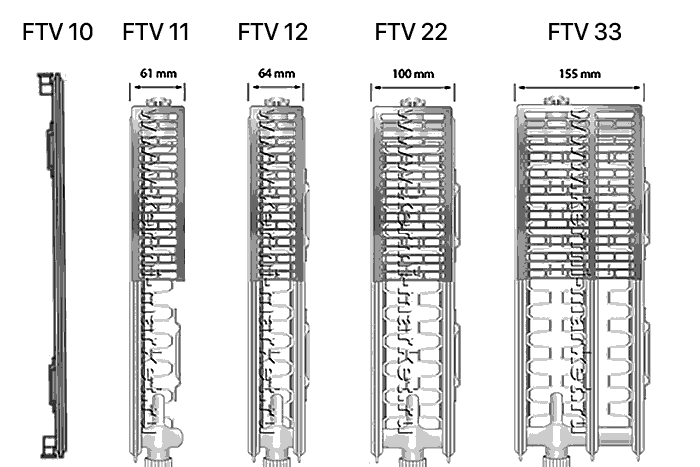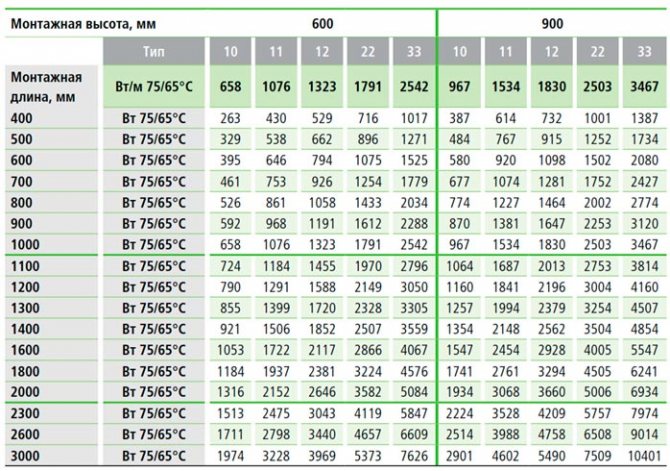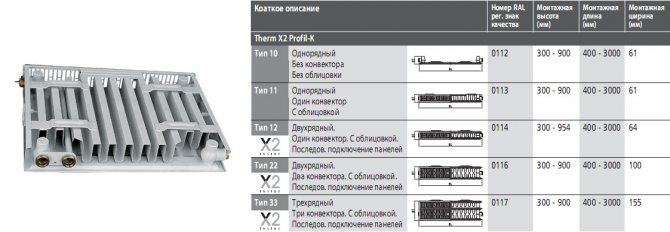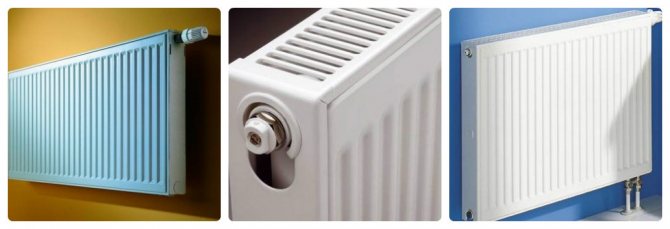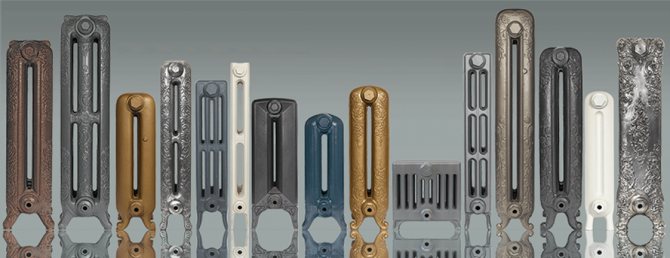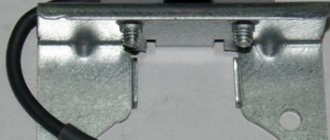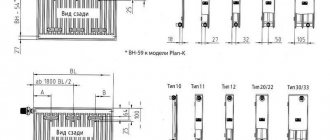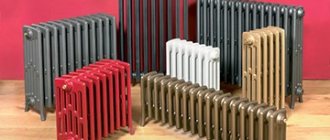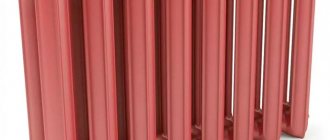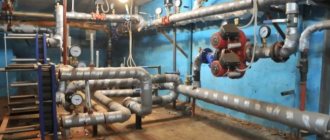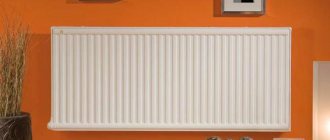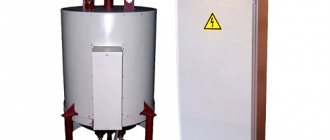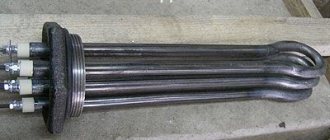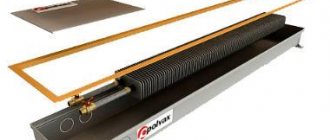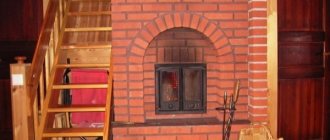Do not overdo it
It should also be noted that 14-15 sections for one radiator is the maximum. It is ineffective to install radiators in 20 or more sections. In this case, divide the number of sections in half and install 2 radiators with 10 sections each. For example, put 1 radiator near the window, and the other near the entrance to the room or on the opposite wall. In general, at your discretion.
Steel radiators are the same story. If the room is large enough and the radiator comes out too large, it is better to put two smaller ones, but with the same total power.
If there are 2 or more windows in a room of the same volume, then a good solution would be to install a radiator under each of the windows. In the case of sectional radiators, everything is quite simple.
14/2 = 7 sections under each window for a room of the same volume
But, since such radiators are usually sold in 10 sections, it is better to take an even number, for example 8. A stock of 1 section will not be superfluous in case of severe frosts. The power will not particularly change from this, however, the inertia of heating of the radiators will decrease. This can be useful if cold air is frequently entering the room. For example, if it is an office space that customers often visit. In such cases, the radiators will heat up the air a little faster.
Radiators "Kermi": characteristics
Smooth and profile models with side and bottom connection have the following technical characteristics:
- Working pressure up to 10 Bar;
- Testing up to 13 bar;
- Maximum coolant temperature + 110oC;
- Inlet connections G 3/4 "or G 1/2";
- Height from 300 mm to 900 mm;
- Length from 400 mm to 3000 mm.
- The heat output depends on the type, height and length.
When choosing, you must use the tables. Read more about choosing the power of a panel radiator here.
The video details the types of Kermi batteries, the connection methods - side and bottom, how to connect different types of pipes and what is needed for this.
What to do after calculation
After calculating the power of heating radiators for all rooms, it will be necessary to select a pipeline in diameter, taps. Number of radiators, length of pipes, number of valves for radiators. Calculate the volume of the entire system and select the appropriate boiler for it.
For a person, home is often associated with warmth and comfort.
And in order for the house to be warm, it is necessary to pay due attention to its heating system. Modern manufacturers use the latest technologies for the production of various elements of heating systems
However, without proper planning of such a system, these technologies may be useless for certain premises.
Steel panel radiators are a competitor to the usual section-type heating devices. They are attractive because, in comparison with all sectional models, with smaller dimensions, they have a higher heat transfer coefficient. They consist of panels in which the coolant moves along the formed passages. There can be several panels: one, two or three. The second component is corrugated metal plates, which are called ribbing. It is due to these plates that a high level of heat transfer of these devices is achieved.
To obtain different heat output, panels and fins are combined in several versions. Each version has a different capacity. To choose the right size and power, you need to know what each of them is. By structure, steel panel batteries are of the following types:
- Type 33 - three-panel. The most powerful class, but also the largest. It has three panels, to which three finning plates are connected (therefore, it is designated 33).
- Type 22 - two-panel with two fins.
- Type 21. Two panels and between them one corrugated metal plate. These heaters, with equal dimensions, have a lower output compared to type 22.
- Type 11. Single-panel steel radiators with one fins. They have even less thermal power, but also less weight and dimensions.
- Type 10. This type has only one heating medium panel. These are the smallest and lightest models.
All of these types can be of different heights and lengths. Obviously, the power of panel radiators depends on both the type and the size. Since it is impossible to calculate this parameter independently, each manufacturer draws up tables in which he enters the test results. These tables are used to select radiators for each room.
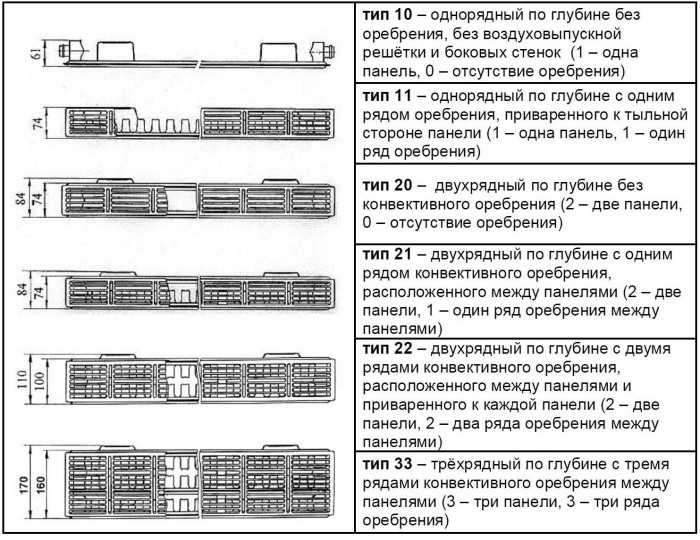
Appearance ↑
Kermi has truly become a recognized leader in its segment. Their steel panel radiators (and not only) have become widely known in the world, and popularity, as you know, is the second component of success. And quality. Today the company produces not only steel batteries that have become traditional for it, but also bimetallic ones. They have two types of connection - bottom and side. And three different thicknesses of metal.
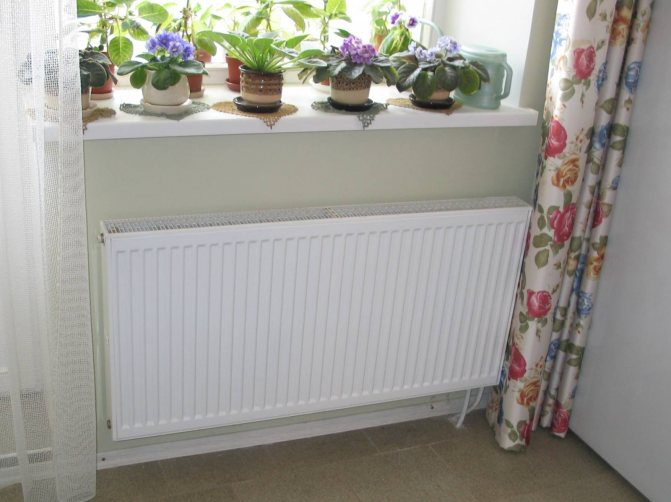

Steel radiators are more suitable for country houses in which the pressure is not as high as in the city. Hydraulic shocks are dangerous for radiators made of steel; bimetallic batteries are capable of holding pressure up to 30 atmospheres.
In order not to take your time, describing their external advantages, I suggest watching a short video about these devices below, so you can make up your own idea of them.


Consumers have an interest in different models, including decorative batteries with unusual stylish designs.
The heating technology of the series of radiators is mainly intended for individual houses and cottages, and have a corresponding appearance: refined, elegant, noble. This is not to say that they are cheap, but, they say, the costs are justified by the high degree of comfort.
In general, the work of any liquid radiator is based on one principle - the coolant (in this case, it is water) enters the radiator tank and slows down, gradually cooling down and transferring heat to the room.
The main advantage of these devices is considered to be their high specific thermal power. So Kermi radiators are considered very powerful.
Batteries transfer heat by thermal radiation from the front surface and have a very decent heat dissipation. They are usually installed in autonomous heating systems, since they are designed for a low operating pressure.
It is difficult to disagree with the fact that the appearance of Kermi brand radiators is quite aesthetic. The batteries are available in various sizes. Radiators are mainly produced in white, they are covered with a special powder coating (as the manufacturer claims, environmentally friendly! I have not yet met any refutations, so it is quite possible, this is true), which seems to keep the temperature longer. But there are decorative models that differ from the main line in both color and design.
Determine the power
The power of steel panel radiators must be determined based on the heat loss of the room in which they will be installed. For apartments located in standard buildings, one can proceed from the SNiP standards, which normalize the required amount of heat per 1m 3 of the heated area:
- Premises in brick buildings require 34W per 1m 3.
- For panel houses for 1m 3 it takes 41W.
Based on these standards, you determine how much heat is required to heat each of the rooms.
For example, a room in a panel house 3.2m * 3.5m, ceiling height 3m. Let's calculate the volume 3.2 * 3.5 * 3 = 33.6m 3. Multiplying by the SNiP norm for panel houses, we get: 33.6 * 41 = 1377.6W.
SNiP standards are indicated for the middle climatic zone. For the rest, there are corresponding coefficients depending on the average temperatures in winter:
- -10 o C and above - 0.7
- -15 o C - 0.9
- -20 o C - 1.1
- -25 o C - 1.3
- -30 o C - 1.5
Correction of heat loss is also needed, depending on the number of external walls, because it is clear that the more such walls, the more heat goes through them. Therefore, we take them into account: if one wall goes out, the coefficient is 1.1, if two, we multiply by 1.2, if three, then we increase by 1.3.


Let's make adjustments for our example. Let the average winter temperatures in the region be -25 ° C, there are two outer walls. It turns out: 1378W * 1.3 * 1.2 = 2149.68W, round off 2150W.
Let's use this figure as an example. Provided that the insulation near the house and windows is average, the figure found is quite accurate.
About the manufacturer ↑
German company Kermi founded back in 1960. Since 1967, the company has been closely engaged in the production of steel panel radiators. (By the way, since 1976 she has also been closely engaged in the production of shower cabins). And by 1975 Kermi achieved a leading position in this segment. Of course most of all Kermi know in Germany itself, but they are also well known in other European countries.
In the Russian market, these heating batteries have shown themselves relatively recently, but they are trusted. And the 5-year manufacturer's warranty certainly captivates.
Panel steel heating radiators KERMI ThermX2
Made according to all European standards, they have a wavy profile surface, and are notable for their low price. They are only suitable for closed heating systems. A small amount of hot water, coupled with a high heat output, make these devices the most suitable for autonomous heating. Moreover, it is better to use them in systems where the coolant is not excessively hot.
These radiators are made according to the latest patented X2 technology, which significantly increased the efficiency of heating devices. By doubling the radiation of the infrared spectrum, this technology has made radiators very comfortable. The heating time has been accelerated by about a quarter, and the savings have increased by 11%. The essence of the X2 principle is that the front panel heats up first, and only then does the rear. For more details, see the video below.
Video: Technical features of Kermi steel panel radiators
After connecting the panels into the body, the finished product is first thoroughly degreased, then phosphated. The final finishing is done by electrostatic painting. The top layer of paint is processed at a temperature of 180 degrees. Thanks to this, it turns out to be durable. The high-gloss finish gives the batteries a fancy look.
On top and on the side, the radiator has screen grilles. They allow to achieve a significant increase in the efficiency of heat transfer - by 60%. The set includes 4 overlays intended for fastening equipment.
There are 2 lines of Kermi panel radiators, which differ in the place of connection to the heating network. Radiators of the Kermi ThermX2 Profil-K (FKO) line are connected from the side. And devices such as Kermi ThermX2 Profil-V (FKV or FTV) are designed to be connected from below.
Laterally connected Kermi ThermX2 Profil-K
These radiators are equipped with convectors, and their panels are made of two profiled steel sheets joined by welding. On the sides there are screens, and on top there is an overhead grill. Radiators with side connection type are marked with the letter combination FKO. For connection to the system, the Kermi Profil-K FKO has four female threaded sockets (1/2 ″ diameter) on the sides. You can connect the radiator to the pipes from either side.
Technical characteristics of heating radiators Kermi ThermX2 FKO:
- Connecting thread: 4 x G1 / 2 ”(female)
- Height: 300, 400, 500, 600, 900
- Center distance: total height minus 50 mm
- Length: 400mm to 3000mm
- Depth: type 10 and 11 - 61mm, type 12 - 64mm, type 22 - 100mm, type 33 - 155mm
- Working pressure - 10 atm. (1.0 MPa)
- Pressure test - 13 atm. (1.3 MPa)
- Max.heating medium temperature: 110 ° C
- Working temperature - 95 °
Bottom-connected Kermi ThermX2 Profil-V
All these radiators have a thermal valve built into the structure. Its thread is right-handed, with a pitch of M30x1.5. The temperature controller is not included in the delivery set, it must be purchased separately. The thread at the branch pipe is external, its diameter is 3/4 ″. The center-to-center distance is 5 cm. This design is intended for two-pipe heating systems. If you need to connect to a one-pipe system, then they purchase special fittings.
Kermi ThermX2 FKV specifications:
- Connecting thread: 2 x G3 / 4 "(external),
- Radiator heights: 300, 400, 500, 600, 900
- Radiator length: 400mm to 3000mm
- Distance between supply pipes: 50mm
- Radiator depth: type 10 and 11 - 61mm, type 12 - 64mm, type 22 - 100mm, type 33 - 155mm
- Working pressure - 10 atm. (1.0 MPa)
- Pressure test - 13 atm. (1.3 MPa)
- Maximum temperature of the heating medium: 110 ° C
- Working temperature - 95 ° С
In addition to the connection methods, panel radiators differ in types. In total Kermi manufactures 5 types of steel panel radiators:
Type 10 - single-row, has a depth of 6.1 cm. There is no cladding and convector. Manufactured by prior order only.


Type 11 - single-row, faced, depth - 6.1 cm. There is one convector.


Type 21 - double-row, lined, with a depth of 6.4 cm. One convector.
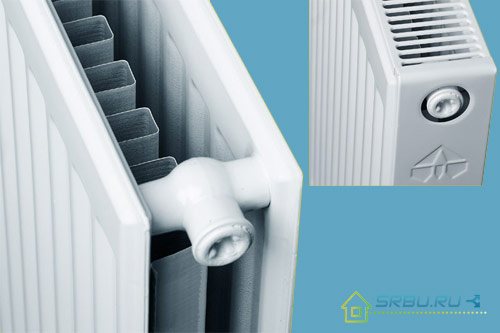

Type 22 - double-row, lined. Two convectors.
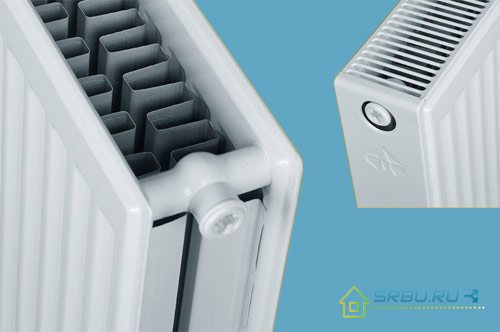

Type 33 - three-row, lined. Three convectors.
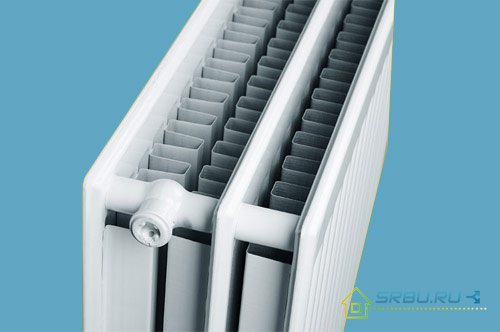

The most popular and frequently used type is 22.
Design features
Any panel radiator consists of steel plates connected in pairs. Channels through which the coolant moves are extruded in the plates by stamping. There are two horizontal channels - one at the top, one at the bottom, and a large number of vertical ones. Plates connected in pairs are assembled into radiators one, two or three pieces. To increase heat transfer, convective ribs can be welded to them - corrugated steel sheets of small thickness. They are located behind the front panel and do not spoil the appearance, and are covered with covers from the side and top.
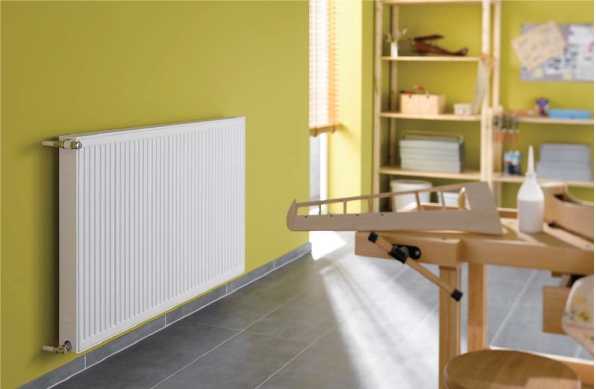

This is a variant of the heating panel with a corrugated front panel.
Kermi batteries are made in exactly the same way. They have a different order of supplying the coolant. All have it parallel. This means that liquid of the same temperature is supplied to all panels in the radiator. This method of feeding works very well at high network temperatures. But as soon as the temperature drops (warming, for example), the radiators become almost cold.
In panel radiators "Kermi" the supply of the heat carrier is sequential and this technology is called Therm-X2. This means that the hottest flow is fed to the first panel, and then to the second and third. Thus, the part that faces the room turns out to be the most heated. And the second and third are colder and colder. In this case, most of the heat goes into the room, and the non-production costs for heating the wall behind the radiator are much lower. Therefore, at the same temperature of the coolant and the same size, Kermi batteries heat the room 25% faster.
The new Therm-X2 technology makes it possible to warm up the room well even in low-temperature operation. This feature makes it possible to use Kermi flat panel radiators not only with traditional heat sources. They work very efficiently with low-potential sources: heat pumps of any type, solar panels and collectors.
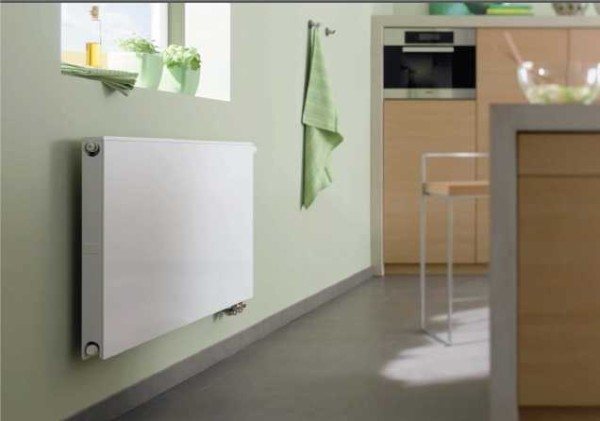

Some may find a smooth surface more attractive.
Another novelty is used in these radiators. The company installs balanced control valves. The balancing parameters were determined as a result of research. All steel radiators with bottom connections are supplied from the factory with balanced and preset thermostats (the thermal head must be purchased separately).By installing such a heating device, you get a stable temperature in the room: the amount of heat carrier is supplied to the collector, which is required to maintain the temperature. You need to change the setting if you are not satisfied with the set mode. Using a thermostat is not only comfort, for individual systems it is also an opportunity to save money: only the required amount of fuel is spent on heating.
There are some other features in the connection of Kermi radiators. Side and bottom piping options are available. Moreover, the bottom can be not only right or left, but can also be located in the center. This allows you to make wiring without being tied to the presence of heating devices, They can generally be installed after finishing work (only you will need to pre-fix the brackets on the wall).
The choice of a radiator based on the calculation
Steel radiators
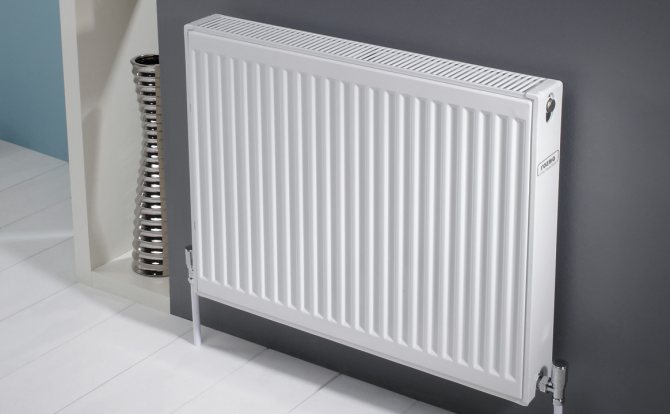

Let's leave in brackets a comparison of different types of heating radiators and note only the nuances that you need to have an idea about when choosing a radiator for your heating system.
In the case of calculating the power of steel heating radiators, everything is simple. There is the required power for an already known room - 2025 watts. In this case, we look at the table and look for steel batteries that produce the required number of watts. Such tables are easy to find on the websites of manufacturers and sellers of similar goods.
Here is an example of such a table:
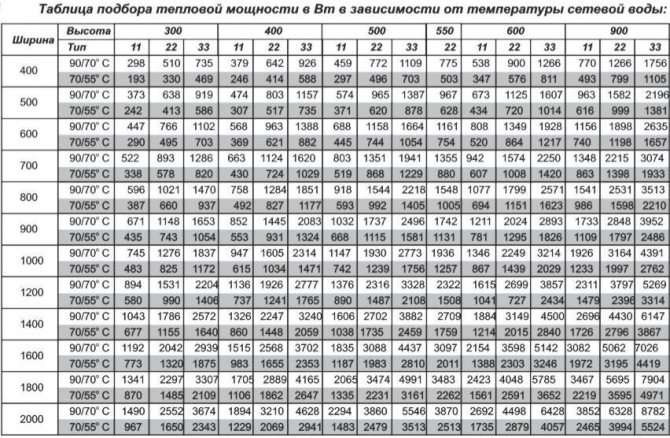

The table indicates the type of radiator, in this example we take type 22, as one of the most popular and quite decent in terms of consumer qualities. And a 600 × 1400 radiator is perfect for us. The power of the heating radiator will be 2020 W. But it's better to take a little more than a little less power.
Aluminum and bimetallic radiators


In this case, there is one important difference in calculating the power of radiators. Aluminum and bimetallic radiators are often sold in sections
And the capacity in tables and catalogs is indicated for one section. Then it is necessary to divide the power required to heat a given room by the power of one section of such a radiator, for example:
2025/150 = 14 (rounded up)
And we got the required number of sections of such a radiator for a room with a volume of 45 cubic meters.
Innovative radiator device Kermi
If the story about the radiators is replete with clichés like “made of high quality sheet steel using the latest technology”, or “durable powder coating of any color”, then you will quickly get bored.
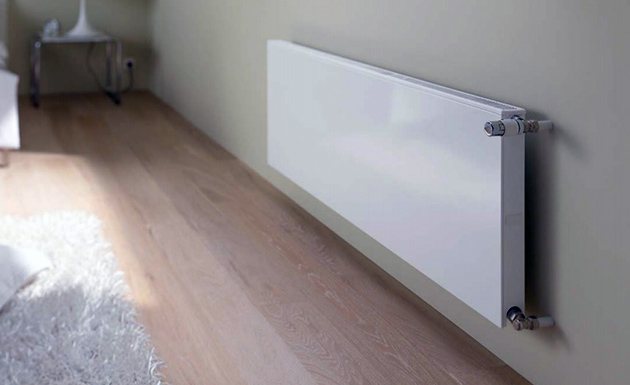

You will say - this is written on the website of any battery manufacturer, everyone praises their products. And you will be right, they write everything well, but how everything is actually done is a question. Therefore, let's go straight to the specific feature that distinguishes Kermi panel radiators from all others.


It would seem, what solutions can still be introduced into heating devices, when everything that is possible has already been invented? It turns out that not all. The Germans added internal piping to the radiators. This allows only the front panel of the device to be heated in normal mode; water does not circulate in the back. But as soon as the room temperature drops, the built-in thermostat will open the way for the coolant to the rear panel, bringing the radiator to full power. Otherwise, these are ordinary steel batteries, only very reliable and made with the highest quality requirements.
Note. In connection with the introduction of a new technology for alternately supplying coolant to the front and rear, the Kermi radiator received the prefix "therm X2" in the designation.
Power calculation
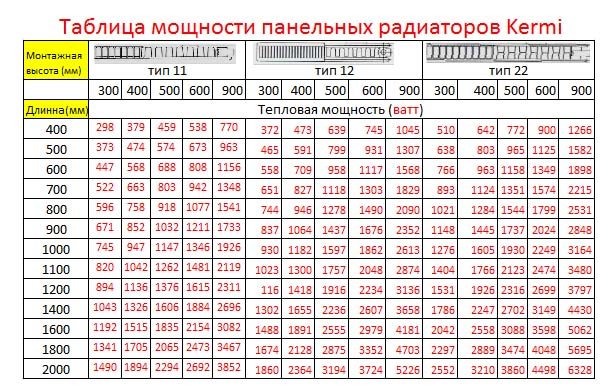

One of the options for calculating the power of a radiator involves the use of a comparative method, when a typical cast-iron 12-section battery is taken as a basis. It is known from the studies carried out that with such dimensions, it provides heat transfer of the order of 1444 W.
The capacity of the internal volume of the cast iron sample filled with the coolant is 13 liters.
From the passport of Kermi batteries, it is easily recognized that the heat transfer from a typical one-section unit under the code 10 is about 2100 W (with a working volume of 6.3 liters).Using these data when replacing cast-iron batteries with new samples, you can be sure that their heat transfer will be no worse, and even slightly higher.


To correctly determine the required power and the radiator connection diagram, a tabular calculation is used. To implement it, you will need the following additional data:
- the amount of heat loss in the apartment;
- parameters of the liquid carrier;
- estimated room average temperature.
When choosing, the dimensions of the radiator are also taken into account, after which the appropriate adjustments are made to the selection algorithm. The required heat transfer value is determined by the summary table provided by the manufacturer of a specific radiator from the popular Kermi line. The required model is in the corresponding column, opposite to which the power value suitable for it is indicated. Experts advise taking this indicator with a small margin, which guarantees the desired result.
After all the parameters have been taken into account, the user will be able to more accurately determine the model suitable for specific operating conditions.
Panel radiator models Kermi
There are two main types: smooth and profiled. Smooth ones have an absolutely flat front panel - called Plan, profile ones - called Profil - and have the usual slightly corrugated surface.
In the group of smooth radiators, there are Plan-V models, which are marked as FKO. These are the same Kermi radiators with bottom connection, and in three versions: left, right, or in the center.
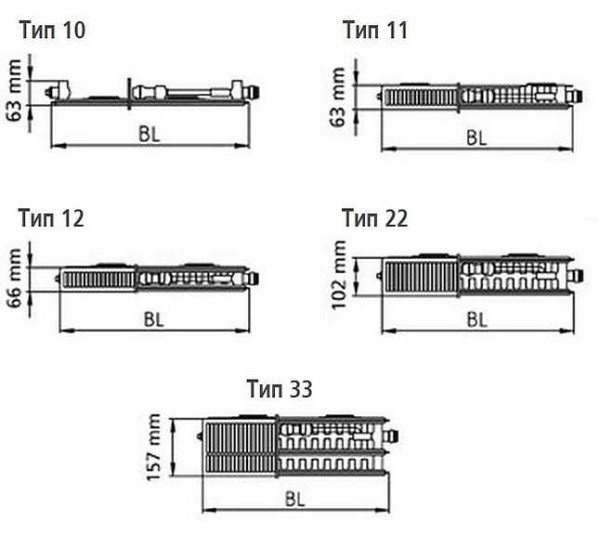

Types and sizes of panel radiators Kermi-Plan
Plan-K models are a side-connected version (FKV marking). In this group, there is an option for replacing old cast iron radiators - with a center distance of 500 mm and 900 mm. In this case, it will not be necessary to digest the liner (if the pipes are in good condition).
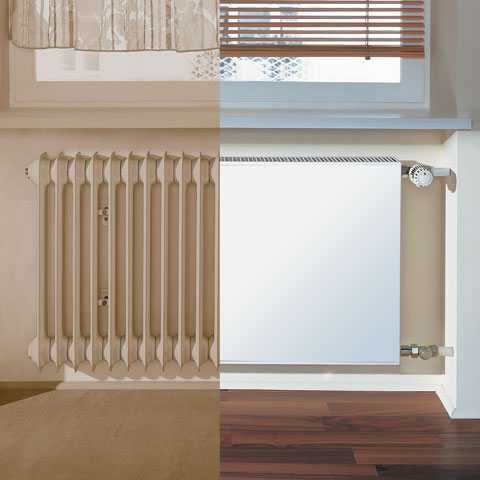

There is a very convenient size for replacing the cast iron battery
FKO and FKV radiators are available in types 10, 11, 21, 22, 33. The first number is the number of panels through which the coolant flows, the second is the number of additional convective plates.
In the group of smooth panel batteries there is Plan-V hygienic - without additional ribs and covers. Such models are required for medical institutions or for those with allergies. The large number of ribs contributes to the accumulation of dust, and the small distances between the plates make cleaning difficult. The hygienic option is free from this disadvantage.
There is an unusual Kermi Verteo Plan. It is a vertical, sleek panel radiator. It will come in handy in cases where it is not possible to find a place for installing a wide radiator. But it must be borne in mind that its working pressure is lower than that of all other models - 6 bar.
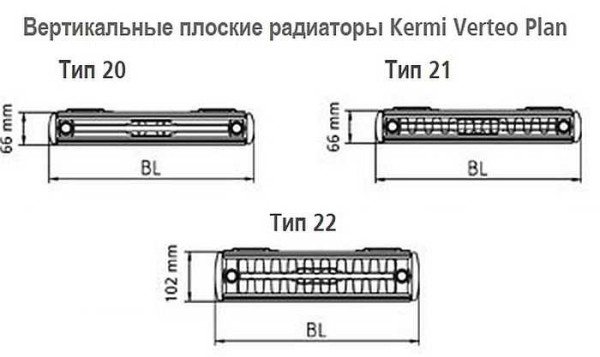

Types and dimensions of Kermi-Verteo-Plan vertical panel radiator
Kermi profile radiators are available in two modifications - Profil -V and Profil -K - lines with bottom (V) and side (K) connections. There is also a modification of the vertical radiators Verteo Profil. The types of these panel batteries are the same, with a slightly shallower depth (2-3mm).
Determination of the power of radiators, based on the area
Building codes determine the average heat consumption per 1 m2 of floor space - 100 W. This is a very approximate indicator, therefore, they often resort to using the formula Q = (2So + Sp + Sns) (0.54Dt + 22), where:
- Q is the required total heat transfer from the radiators;
- Dt is the difference between outdoor and indoor temperatures;
- So is the area of the windows;
- Sp is the floor area;
- Sns - the area of the "street" walls.
Choosing the Kermi model (radiators), the power is calculated using this formula, but taking into account the heat loss inherent in a particular room. The exact indicators can be determined by specialists.
There are two connection options for Kermi flat panel radiators:
- Profile radiator compact therm X2 Profil K - Lateral connection FKO
- Valve radiator compact Profil V - Bottom connection FTV (FKV)
To obtain a different thermal power radiators Kermi, panels and fins are combined in several versions, and have different power (heat transfer).To choose the right size and power, you need to know what each of them is. In terms of structure, Kermi steel panel batteries are of the following types:
- Type 10 - This type has only one heating medium panel. These are the smallest and lightest models without cladding, single-row radiators with an installation depth - 61 mm;
- Type 11 - Single panel steel radiators with one fins. has the same characteristics as 10, but with cladding and installation depth - 61 mm;
- Type 12 - Two panels and between them one corrugated metal plate, fast flow, installation depth - 64 mm;
- Type 22 - perhaps the most popular type of Kermi radiators, two-panel, with two fins, installation depth - 100 mm;
- Type 33 - three-panel. The most powerful class, but also the largest. Has three panels, to which three fins are connected, have a fast flow and installation depth - 155 mm.
All these types can have different heights. 200 (22 and 33 types) 300, 400, 500, 600 and 900 mm. and length 400, 500, 600, 700, 800, 900, 1000, 1100, 1200, 1300, 1400, 1600, 1800, 2000, 2300, 2600 and 3000 mm.
| RADIATOR KERMI WITH SIDE CONNECTION FKO | RADIATOR KERMI WITH BOTTOM CONNECTION FTV | |||
| Kermi FKO 10 | Kermi FKV 10 | |||
| Kermi FKO 11 | Kermi FKV 11 | |||
| Kermi FKO 12 | Kermi FKV 12 | |||
| Kermi FKO 22 | Kermi FKV 22 | |||
| Kermi FKO 33 | Kermi FKV 33 |
Area calculation
- This is the simplest way to determine the more or less accurate amount of heat required for heating. When calculating, the main starting point is the area of an apartment or house where heating is organized. The value of the area of each room is shown in the apartment plan. For an average climatic zone, the norm for a dwelling is defined as 100 W / 1 sq.m.
- But since not all apartments have exactly such parameters and layouts, there are some indicators that should be taken into account when calculating the number of radiator sections for each specific apartment.
- If the room has not one outer wall, but two, then 100 Watts / sq. m. you need to add another 20%. And if there are not one windows, but 2 or 3 (with two outer walls), then these are 100 Watts / sq. m. you need to add 30%. If both windows face the colder north side or northeast, then add another 10% to the total. All! That's the whole calculation !!! And no formulas are needed))
- The features of the placement of the radiator Kermi... If you plan to install it in a so-called open niche, then you need to "throw" another 5% to the amount already received, and if in a closed one, then all 15%. Only by taking into account all these features of the room, you can really correctly calculate the heat transfer of the heater, which will be most optimal for a particular apartment in these climatic conditions.
Technical characteristics of heating radiators Kermi ThermX2 FKO:
- Connecting thread: 4 x G1 / 2 " (int.)
- Height: 300, 400, 500, 600, 900 mm.
- Length: from 400 mm to 3000 mm.
- Depth: type 10 and 11 — 61 mm, type 12 — 64 mm, type 22 — 100 mm, type 33 — 155 mm.
- Operating pressure - 10 atm... (1.0 MPa).
- Pressure test - 13 atm... (1.3 MPa).
- Max. coolant temperature: 110 ° C.
- Working temperature - 95°.
Kermi ThermX2 FKV specifications:
- Connecting thread: 2 x G3 / 4 " (outside).
- Radiator height: 300, 400, 500, 600, 900 mm.
- Radiators length: from 400 mm to 3000 mm.
- The distance between the supply pipes (center-to-center distance) is calculated as follows: the height of this radiator minus 56 mm (for example, the height of the battery is 500 mm - 56 mm = 444 mm, i.e. 444 mm is the center distance).
- Radiator depth: type 10 and 11 — 61 mm, type 12 - 64 mm, type 22 - 100 mm, type 33 - 155 mm.
- Operating pressure - 10 atm... (1.0 MPa).
- Maximum coolant temperature: 110 ° C.
- Working temperature - 95 ° C.
- Pressure test - 13 atm... (1.3 MPa).
Contents of delivery:
- Profile radiators Kermi therm-x2 with fixing plates (except for installation height 200), surface powder coated with a preliminary primer;
- Side strips and top grille (except type 10) are removable for cleaning;
- Mounting accessories included at no extra charge (excluding installation height 200);
- Compact profile radiators therm-x2: Type 12 - 33 additionally with dividing plug therm-x2 (except for installation height 200).
Fastening
- Fastening for 4 straps up to a length of 1600 mm and for 6 straps from a length of 1800 mm (installation height 200 without straps);
- Possible alignment horizontally and vertically when mounted.
Coating
- Shiny two-layer paint coating, does not emit harmful substances, uniform and environmentally friendly;
- Compliant DIN 55900-FWA: surface degreased, phosphated, primed with cathodic dipping (ETL) and powder coated (EPS); Standard finish: Kermi white (similar to RAL 9016);
- The color of the paintwork is from the Kermi color range.
Quality
- RAL checked;
- All radiators are leak tested;
- Control pressure: 13 bar;
- Max. operating pressure: 10 bar;
- Max. working temperature: 110 ° C;
- Certification according to DIN EN ISO 9001: 2008.
Packaging
- Supplied pre-assembled in a cardboard box, packed in a protective film;
- The protective packaging for installation on construction sites does not need to be removed during installation.
Connection
- Therm-x2 compact profile radiators: 4 x G 1/2 “female thread;
- Profile valve radiators therm-x2: 2 x G 3/4 ″ male thread, standard connection at bottom right, optional connection at bottom left at no extra charge 3 x G 1/2 ″ female thread on the side;
- Profile valve radiators therm-x2 with central connection: 2 x G 3/4 “male thread, connection at the bottom center, the valve is standard on the right. On request, a design with a valve on the left is possible (no extra charge). The supply line is always on the left, regardless of the valve location. The distance to the wall is the same for all multi-panel radiators;
- Mounting height 200 without x2 INSIDE.
Additionally for valve radiators:
- The valve is adjusted to the heat output of the radiator using the factory default kv value;
- Plugs and air vent valves are installed and sealed.
5 year warranty
- The warranty applies only to radiators installed in a closed heating system.
* For technical information of Kermi profile steel radiators, see below.
Our online store is the official dealer of the company Kermi, in full range at the best prices in Moscow, we offer you steel radiators Kermi and accessories at competitive prices!
Radiators Kermi - this is a guarantee of the flawless functioning of the heating system at home, not only for you, but also for your children and grandchildren!
